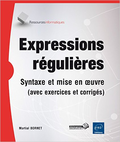GNU/Linux man pages
Livre :
Expressions régulières,
Syntaxe et mise en oeuvre :


GNU/Linux |
Debian 6.0.5(Squeeze) |
|
 |
namei(1) |
 |
namei - follow a pathname until a terminal point is found
namei [options] pathname...
Namei uses its arguments as pathnames to any type of Unix file (symlinks, files, directories, and so forth). Namei then follows each pathname until a terminal point is found (a file, directory, char device, etc). If it finds a symbolic link, we show the link, and start following it, indenting the output to show the context.
This program is useful for finding a "too many levels of symbolic links" problems.
For each line output, namei outputs a the following characters to identify the file types found:
f: = the
pathname we are currently trying to resolve
d = directory
l = symbolic link (both the link and it’s contents are
output)
s = socket
b = block device
c = character device
p = FIFO (named pipe)
- = regular file
? = an error of some kind
Namei prints an informative message when the maximum number of symbolic links this system can have has been exceeded.
−l, −−long
Use a long listing format (same as -m -o -v).
−m, −−modes
Show the mode bits of each file type in the style of ls(1), for example ’rwxr-xr-x’.
−o, −−owners
Show owner and group name of each file.
−n, −−nosymlinks
Don’t follow symlinks.
−v, −−vertical
Vertical align of modes and owners.
−x, −−mountpoints
Show mount point directories with a ’D’, rather than a ’d’.
The original namei program was written by Roger Southwick <rogers@amadeus.wr.tek.com>.
The program was re-written by Karel Zak <kzak@redhat.com>.
To be discovered.
ls(1), stat(1)
The namei command is part of the util-linux-ng package and is available from ftp://ftp.kernel.org/pub/linux/utils/util-linux-ng/.
 |
namei(1) |  |